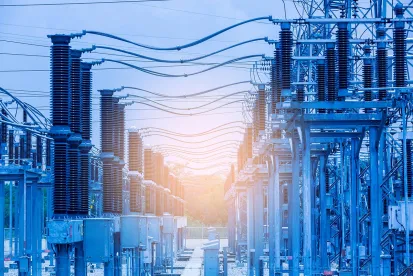Introduction: On November 18, 2021, the Federal Energy Regulatory Commission (“FERC” or “Commission”) issued a notice of inquiry seeking comments on various aspects of currently accepted reactive power compensation mechanisms and alternative compensation methodologies, including for those resources that interconnect at the distribution level but offer reactive power capability in support of transmission. The NOI may foreshadow FERC’s adoption for the first time of a uniform standard for reactive power compensation, displacing the current fragmented reactive power federal pricing environment.
Why you are affected: Proposals to the Commission may urge setting reactive power rates based upon: more accurate assessments of individual facilities’ costs;[1] an average of regional costs; “fleet” costs;[2] performance criteria;[3] temporal factors, such as time of day or seasonal differentiations; rate caps; safe harbor rates with an option to justify an individual facility’s higher costs; replacement value; locational value; other bases; or proposals to entirely eliminate separate reactive power rates.[4] The NOI likely will involve not only the traditional utility rate debate of fairness versus efficiency, but also differing perspectives on who is the true “cost causer”; whether solar and wind resources should be subject to specific rule changes;[5] the impact of reactive power pricing on transmission system development and new generation assets’ location; whether some form of dynamic pricing would be desirable or administratively infeasible; and whether a single rate or compensation methodology would properly incent the siting of reactive power resources where they are most needed. Different types of reactive power providers (to say nothing of consumers) will disagree on the proper method for pricing reactive power. For instance, low-cost providers might prefer a “flat rate” (see, e.g., NOI at P 30) regional average price, allowing them additional margin above a strict cost-based, facility-specific rate. Higher-cost providers could be disadvantaged by such a compensation program. Similarly, some participants may focus on arbitrage opportunities created by separate reactive power pricing regimes.
The NOI may impact generation resource owners, developers, investors, and transmission customers because reactive power compensation (i) may involve significant revenues or costs for such participants, (ii) may eliminate or reduce FERC proceedings otherwise regularly set for settlement and hearing, which consume significant resources and (iii) presently is subject to uncertainty and unpredictability. Thus, market participants that receive, pay, or anticipate receiving or paying, reactive power rates would be well-served by commenting in this proceeding.
Background: Reactive power maintains voltage support necessary for power to actually flow on a line, which must be controlled for system reliability.[6] Resources supply or consume reactive power in order to maintain stable voltage essential to reliable transmission of power from generation resources to load. Reactive power is increasingly important, both because of long-distance transmission related to greater use of renewable resources (e.g., wind in the Great Plains must be transported to distant load centers) and because intermittent resources’ flows may vary starkly in volume and direction (e.g., based on time of day). Thus getting the issue “right” has increasing significance to the industry, and can impact resource location.
Although costs associated with installing reactive power facilities as part of the transmission system have been recovered as part of basic transmission service, use of generation resources to supply reactive power has been compensated as a separate ancillary service (i.e., unbundled from basic transmission service).[7] The predominant method of calculating separate reactive power rates is the so-called AEP Methodology, which allocates the costs of synchronous generator equipment between reactive power capability and non-reactive power capability, as well as related operations and maintenance costs.[8] While the Commission has recommended the AEP Methodology for calculating reactive power compensation in many instances, its uniform use has not been required. The result is a patchwork of different mechanisms and methodologies, with some regions not permitting separately-stated compensation for reactive power at all.[9]
This lack of uniformity has produced high regulatory costs[10] and uncertainty. In just two RTOs, FERC has processed more than 385 specific reactive power proceedings, setting at least 135 for hearing and settlement procedures.[11] The NOI may result in an industry-wide standard. FERC seeks comments regarding features of the AEP Methodology, potential alternative compensation methodologies and compensation through transmission rates for resources that interconnect at the distribution level (the actual contribution of which, the NOI notes, has been questioned).[12]
Relevant Timeline: Initial comments are due 60 days, and reply comments are due 90 days, after the NOI’s publication in the Federal Register.
FOOTNOTES
[1] NOI at PP 25, 28j-s.
[2] Id. at PP 12, 28j-i.
[3] Cf. NOI at PP 13, 21.
[4] NOI at P 28a.
[5] Id. at P 28j-o.
[6] Id. at P 4.
[7] Promoting Wholesale Competition Through Open Access Non-Discriminatory Transmission Services by Public Utilities; Recovery of Stranded Costs by Public Utilities and Transmitting Utilities, Order No. 888, 61 FR 21540-01, at 21581-21582 (1996), order on reh’g, Order No. 888-A, FERC Stats. & Regs. ¶ 31,048, order on reh’g, Order No. 888-B, 81 FERC ¶ 61,248 (1997), order on reh’g, Order No. 888-C, 82 FERC ¶ 61,046 (1998), aff’d in relevant part sub nom. Transmission Access Policy Study Group v. FERC, 225 F.3d 667 (D.C. Cir. 2000), aff’d sub nom. New York v. FERC, 535 U.S. 1 (2002).
[8] See Am. Elec. Power Serv. Corp., Opinion No. 440, 88 FERC ⁋ 61,141 (1999).
[9] In CAISO, SPP and several non-RTO regions, resources are not compensated for reactive power capability. In ISO New England and NYISO, resources are compensated for reactive power using a flat rate (i.e., $/mega-volt Ampere), multiplied by a resource’s tested reactive power capability.
[10] See, e.g., NOI at P 25.
[11] See Staff Presentation, Notice of Inquiry (NOI) regarding Reactive Power Capability Compensation (accessed at Staff Presentation | Notice of Inquiry (NOI) regarding Reactive Power Capability Compensation | Federal Energy Regulatory Commission (ferc.gov)).
[12] NOI at PP 34-36.




 />i
/>i

